tire type FORD F750 2010 12.G Owners Manual
[x] Cancel search | Manufacturer: FORD, Model Year: 2010, Model line: F750, Model: FORD F750 2010 12.GPages: 274, PDF Size: 1.51 MB
Page 132 of 274
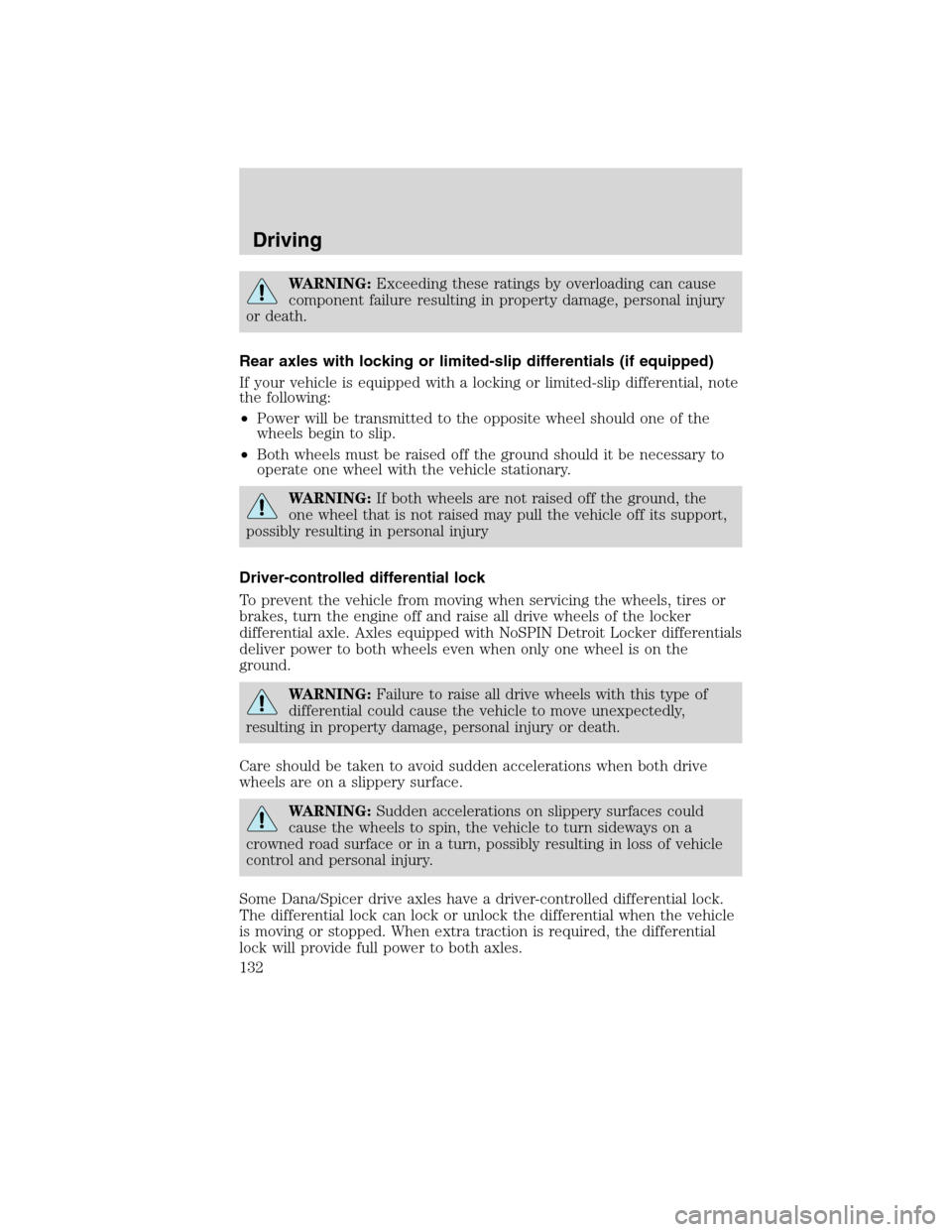
WARNING:Exceeding these ratings by overloading can cause
component failure resulting in property damage, personal injury
or death.
Rear axles with locking or limited-slip differentials (if equipped)
If your vehicle is equipped with a locking or limited-slip differential, note
the following:
•Power will be transmitted to the opposite wheel should one of the
wheels begin to slip.
•Both wheels must be raised off the ground should it be necessary to
operate one wheel with the vehicle stationary.
WARNING:If both wheels are not raised off the ground, the
one wheel that is not raised may pull the vehicle off its support,
possibly resulting in personal injury
Driver-controlled differential lock
To prevent the vehicle from moving when servicing the wheels, tires or
brakes, turn the engine off and raise all drive wheels of the locker
differential axle. Axles equipped with NoSPIN Detroit Locker differentials
deliver power to both wheels even when only one wheel is on the
ground.
WARNING:Failure to raise all drive wheels with this type of
differential could cause the vehicle to move unexpectedly,
resulting in property damage, personal injury or death.
Care should be taken to avoid sudden accelerations when both drive
wheels are on a slippery surface.
WARNING:Sudden accelerations on slippery surfaces could
cause the wheels to spin, the vehicle to turn sideways on a
crowned road surface or in a turn, possibly resulting in loss of vehicle
control and personal injury.
Some Dana/Spicer drive axles have a driver-controlled differential lock.
The differential lock can lock or unlock the differential when the vehicle
is moving or stopped. When extra traction is required, the differential
lock will provide full power to both axles.
Driving
132
2010 F-650/750(f67)
Supplement(supplement), 1st Printing
USA(fus)
Page 171 of 274
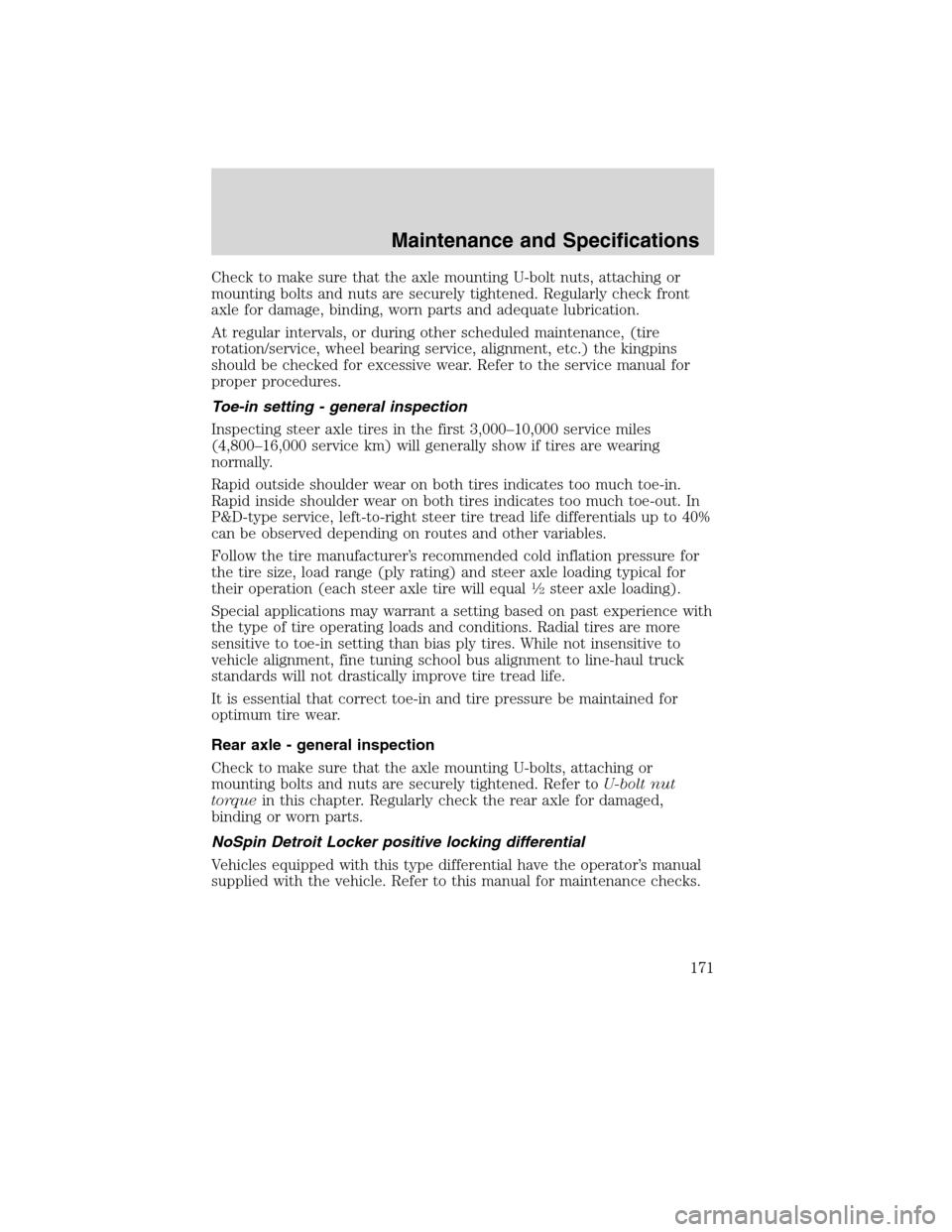
Check to make sure that the axle mounting U-bolt nuts, attaching or
mounting bolts and nuts are securely tightened. Regularly check front
axle for damage, binding, worn parts and adequate lubrication.
At regular intervals, or during other scheduled maintenance, (tire
rotation/service, wheel bearing service, alignment, etc.) the kingpins
should be checked for excessive wear. Refer to the service manual for
proper procedures.
Toe-in setting - general inspection
Inspecting steer axle tires in the first 3,000–10,000 service miles
(4,800–16,000 service km) will generally show if tires are wearing
normally.
Rapid outside shoulder wear on both tires indicates too much toe-in.
Rapid inside shoulder wear on both tires indicates too much toe-out. In
P&D-type service, left-to-right steer tire tread life differentials up to 40%
can be observed depending on routes and other variables.
Follow the tire manufacturer’s recommended cold inflation pressure for
the tire size, load range (ply rating) and steer axle loading typical for
their operation (each steer axle tire will equal
1�2steer axle loading).
Special applications may warrant a setting based on past experience with
the type of tire operating loads and conditions. Radial tires are more
sensitive to toe-in setting than bias ply tires. While not insensitive to
vehicle alignment, fine tuning school bus alignment to line-haul truck
standards will not drastically improve tire tread life.
It is essential that correct toe-in and tire pressure be maintained for
optimum tire wear.
Rear axle - general inspection
Check to make sure that the axle mounting U-bolts, attaching or
mounting bolts and nuts are securely tightened. Refer toU-bolt nut
torquein this chapter. Regularly check the rear axle for damaged,
binding or worn parts.
NoSpin Detroit Locker positive locking differential
Vehicles equipped with this type differential have the operator’s manual
supplied with the vehicle. Refer to this manual for maintenance checks.
Maintenance and Specifications
171
2010 F-650/750(f67)
Supplement(supplement), 1st Printing
USA(fus)
Page 206 of 274
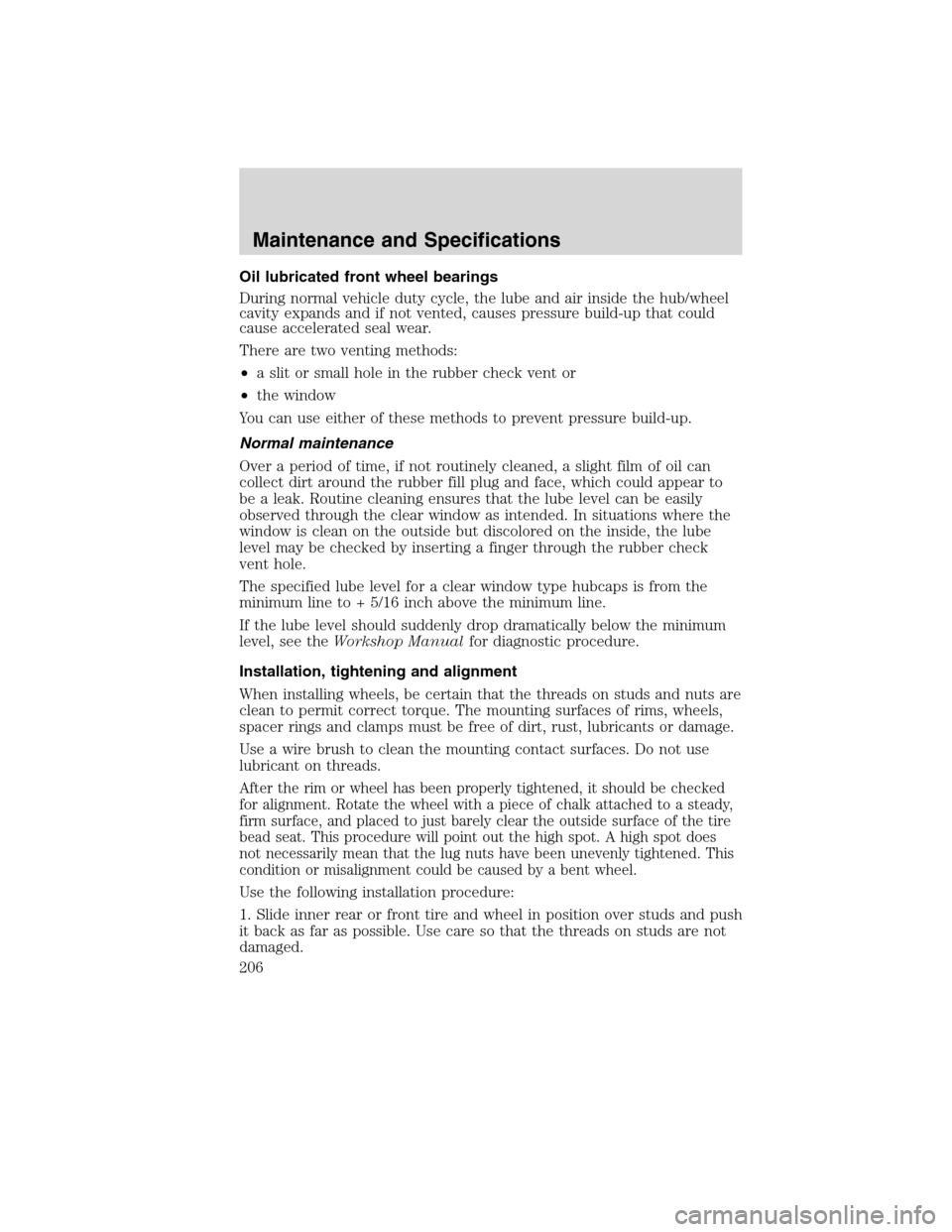
Oil lubricated front wheel bearings
During normal vehicle duty cycle, the lube and air inside the hub/wheel
cavity expands and if not vented, causes pressure build-up that could
cause accelerated seal wear.
There are two venting methods:
•a slit or small hole in the rubber check vent or
•the window
You can use either of these methods to prevent pressure build-up.
Normal maintenance
Over a period of time, if not routinely cleaned, a slight film of oil can
collect dirt around the rubber fill plug and face, which could appear to
be a leak. Routine cleaning ensures that the lube level can be easily
observed through the clear window as intended. In situations where the
window is clean on the outside but discolored on the inside, the lube
level may be checked by inserting a finger through the rubber check
vent hole.
The specified lube level for a clear window type hubcaps is from the
minimum line to + 5/16 inch above the minimum line.
If the lube level should suddenly drop dramatically below the minimum
level, see theWorkshop Manualfor diagnostic procedure.
Installation, tightening and alignment
When installing wheels, be certain that the threads on studs and nuts are
clean to permit correct torque. The mounting surfaces of rims, wheels,
spacer rings and clamps must be free of dirt, rust, lubricants or damage.
Use a wire brush to clean the mounting contact surfaces. Do not use
lubricant on threads.
After the rim or wheel has been properly tightened, it should be checked
for alignment. Rotate the wheel with a piece of chalk attached to a steady,
firm surface, and placed to just barely clear the outside surface of the tire
bead seat. This procedure will point out the high spot. A high spot does
not necessarily mean that the lug nuts have been unevenly tightened. This
condition or misalignment could be caused by a bent wheel.
Use the following installation procedure:
1. Slide inner rear or front tire and wheel in position over studs and push
it back as far as possible. Use care so that the threads on studs are not
damaged.
Maintenance and Specifications
206
2010 F-650/750(f67)
Supplement(supplement), 1st Printing
USA(fus)
Page 210 of 274
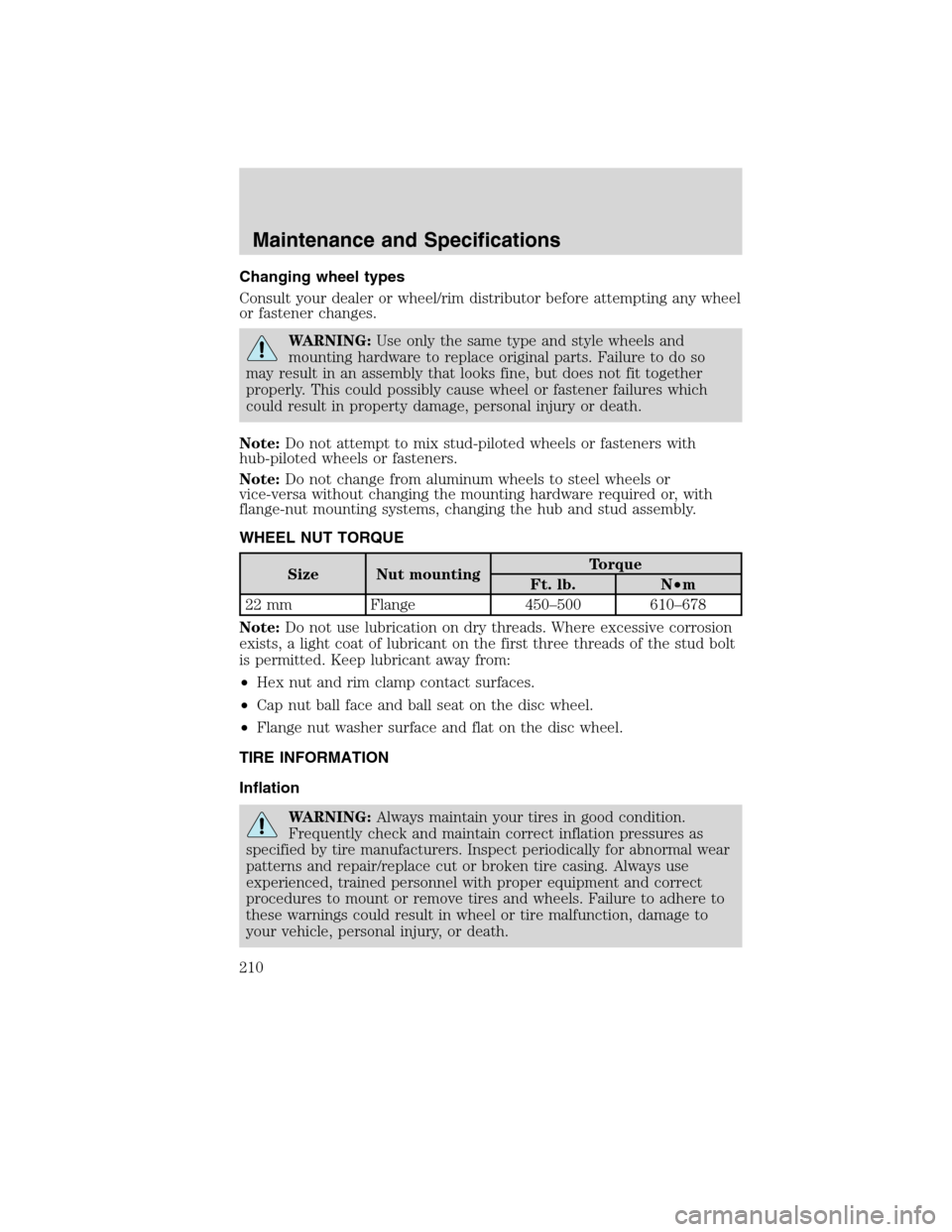
Changing wheel types
Consult your dealer or wheel/rim distributor before attempting any wheel
or fastener changes.
WARNING:Use only the same type and style wheels and
mounting hardware to replace original parts. Failure to do so
may result in an assembly that looks fine, but does not fit together
properly. This could possibly cause wheel or fastener failures which
could result in property damage, personal injury or death.
Note:Do not attempt to mix stud-piloted wheels or fasteners with
hub-piloted wheels or fasteners.
Note:Do not change from aluminum wheels to steel wheels or
vice-versa without changing the mounting hardware required or, with
flange-nut mounting systems, changing the hub and stud assembly.
WHEEL NUT TORQUE
Size Nut mountingTorque
Ft. lb. N•m
22 mm Flange 450–500 610–678
Note:Do not use lubrication on dry threads. Where excessive corrosion
exists, a light coat of lubricant on the first three threads of the stud bolt
is permitted. Keep lubricant away from:
•Hex nut and rim clamp contact surfaces.
•Cap nut ball face and ball seat on the disc wheel.
•Flange nut washer surface and flat on the disc wheel.
TIRE INFORMATION
Inflation
WARNING:Always maintain your tires in good condition.
Frequently check and maintain correct inflation pressures as
specified by tire manufacturers. Inspect periodically for abnormal wear
patterns and repair/replace cut or broken tire casing. Always use
experienced, trained personnel with proper equipment and correct
procedures to mount or remove tires and wheels. Failure to adhere to
these warnings could result in wheel or tire malfunction, damage to
your vehicle, personal injury, or death.
Maintenance and Specifications
210
2010 F-650/750(f67)
Supplement(supplement), 1st Printing
USA(fus)
Page 212 of 274
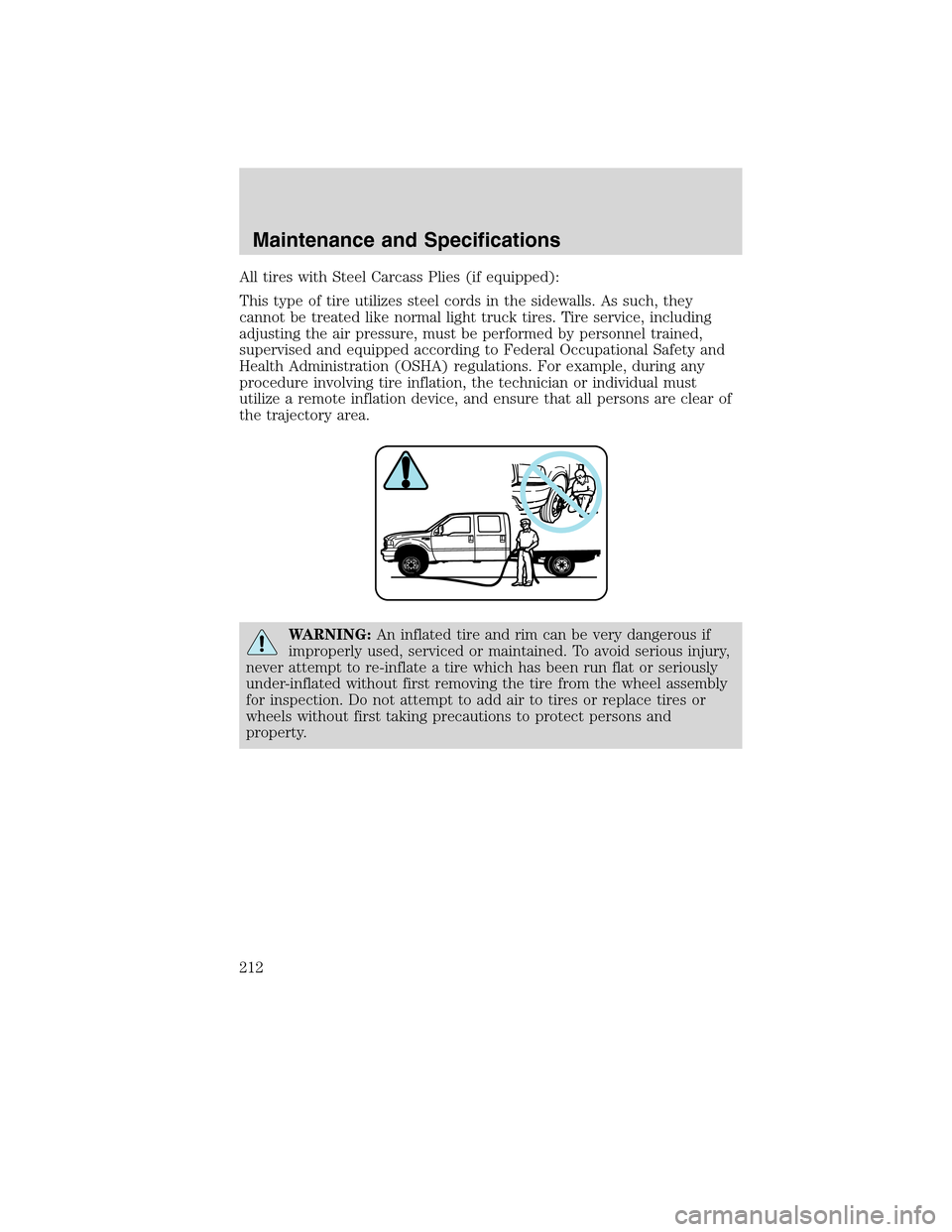
All tires with Steel Carcass Plies (if equipped):
This type of tire utilizes steel cords in the sidewalls. As such, they
cannot be treated like normal light truck tires. Tire service, including
adjusting the air pressure, must be performed by personnel trained,
supervised and equipped according to Federal Occupational Safety and
Health Administration (OSHA) regulations. For example, during any
procedure involving tire inflation, the technician or individual must
utilize a remote inflation device, and ensure that all persons are clear of
the trajectory area.
WARNING:An inflated tire and rim can be very dangerous if
improperly used, serviced or maintained. To avoid serious injury,
never attempt to re-inflate a tire which has been run flat or seriously
under-inflated without first removing the tire from the wheel assembly
for inspection. Do not attempt to add air to tires or replace tires or
wheels without first taking precautions to protect persons and
property.
Maintenance and Specifications
212
2010 F-650/750(f67)
Supplement(supplement), 1st Printing
USA(fus)
Page 213 of 274
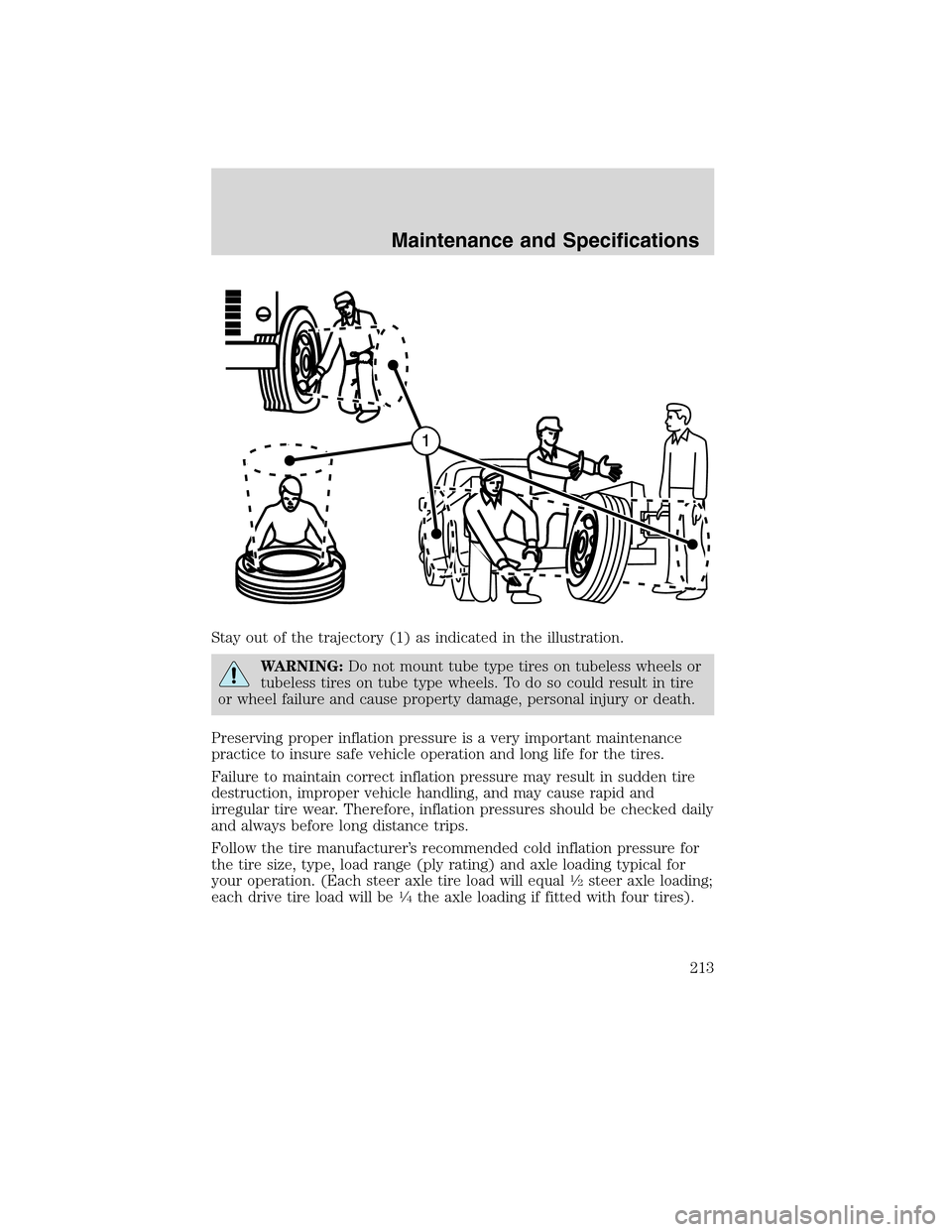
Stay out of the trajectory (1) as indicated in the illustration.
WARNING:Do not mount tube type tires on tubeless wheels or
tubeless tires on tube type wheels. To do so could result in tire
or wheel failure and cause property damage, personal injury or death.
Preserving proper inflation pressure is a very important maintenance
practice to insure safe vehicle operation and long life for the tires.
Failure to maintain correct inflation pressure may result in sudden tire
destruction, improper vehicle handling, and may cause rapid and
irregular tire wear. Therefore, inflation pressures should be checked daily
and always before long distance trips.
Follow the tire manufacturer’s recommended cold inflation pressure for
the tire size, type, load range (ply rating) and axle loading typical for
your operation. (Each steer axle tire load will equal
1�2steer axle loading;
each drive tire load will be1�4the axle loading if fitted with four tires).
Maintenance and Specifications
213
2010 F-650/750(f67)
Supplement(supplement), 1st Printing
USA(fus)
Page 216 of 274
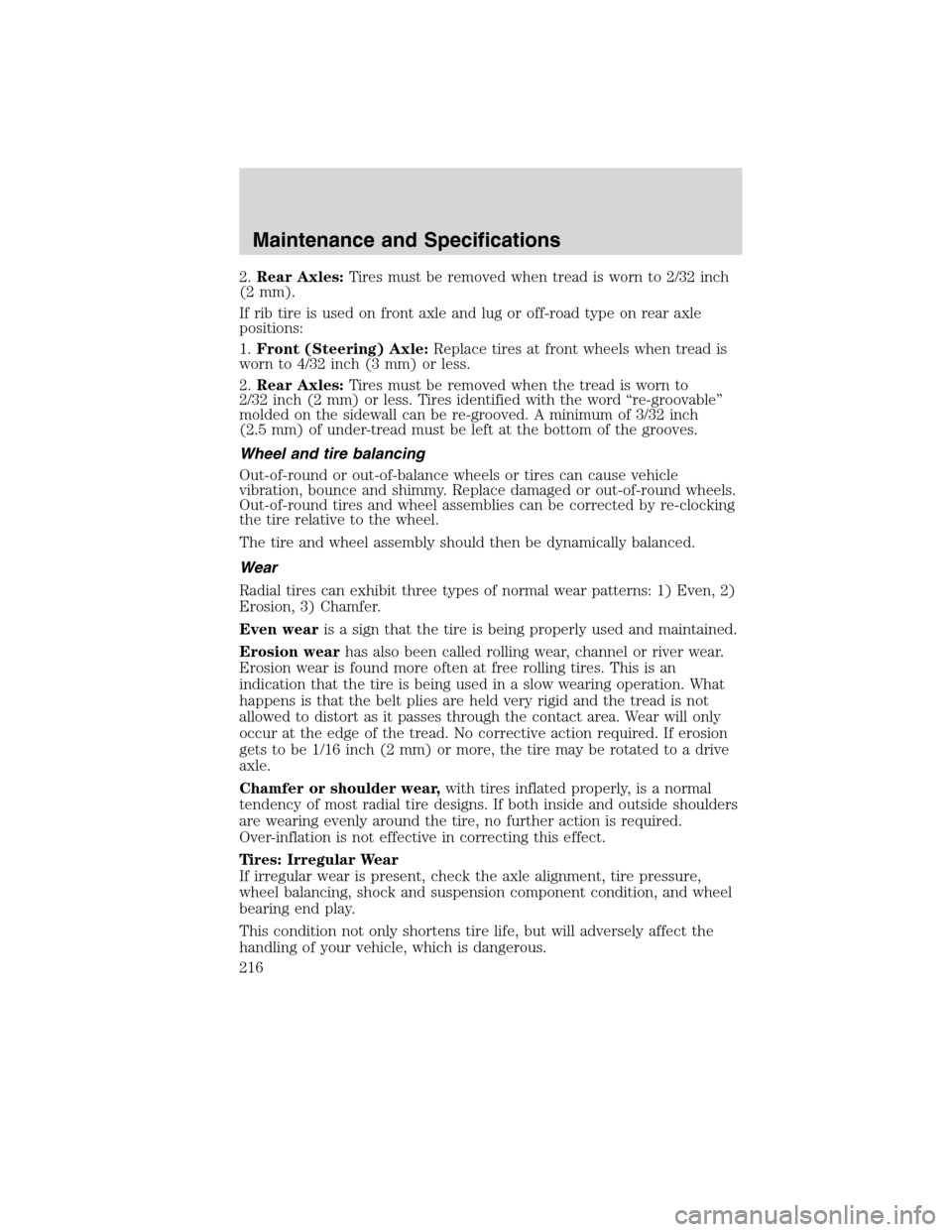
2.Rear Axles:Tires must be removed when tread is worn to 2/32 inch
(2 mm).
If rib tire is used on front axle and lug or off-road type on rear axle
positions:
1.Front (Steering) Axle:Replace tires at front wheels when tread is
worn to 4/32 inch (3 mm) or less.
2.Rear Axles:Tires must be removed when the tread is worn to
2/32 inch (2 mm) or less. Tires identified with the word “re-groovable”
molded on the sidewall can be re-grooved. A minimum of 3/32 inch
(2.5 mm) of under-tread must be left at the bottom of the grooves.
Wheel and tire balancing
Out-of-round or out-of-balance wheels or tires can cause vehicle
vibration, bounce and shimmy. Replace damaged or out-of-round wheels.
Out-of-round tires and wheel assemblies can be corrected by re-clocking
the tire relative to the wheel.
The tire and wheel assembly should then be dynamically balanced.
Wear
Radial tires can exhibit three types of normal wear patterns: 1) Even, 2)
Erosion, 3) Chamfer.
Even wearis a sign that the tire is being properly used and maintained.
Erosion wearhas also been called rolling wear, channel or river wear.
Erosion wear is found more often at free rolling tires. This is an
indication that the tire is being used in a slow wearing operation. What
happens is that the belt plies are held very rigid and the tread is not
allowed to distort as it passes through the contact area. Wear will only
occur at the edge of the tread. No corrective action required. If erosion
gets to be 1/16 inch (2 mm) or more, the tire may be rotated to a drive
axle.
Chamfer or shoulder wear,with tires inflated properly, is a normal
tendency of most radial tire designs. If both inside and outside shoulders
are wearing evenly around the tire, no further action is required.
Over-inflation is not effective in correcting this effect.
Tires: Irregular Wear
If irregular wear is present, check the axle alignment, tire pressure,
wheel balancing, shock and suspension component condition, and wheel
bearing end play.
This condition not only shortens tire life, but will adversely affect the
handling of your vehicle, which is dangerous.
Maintenance and Specifications
216
2010 F-650/750(f67)
Supplement(supplement), 1st Printing
USA(fus)
Page 217 of 274
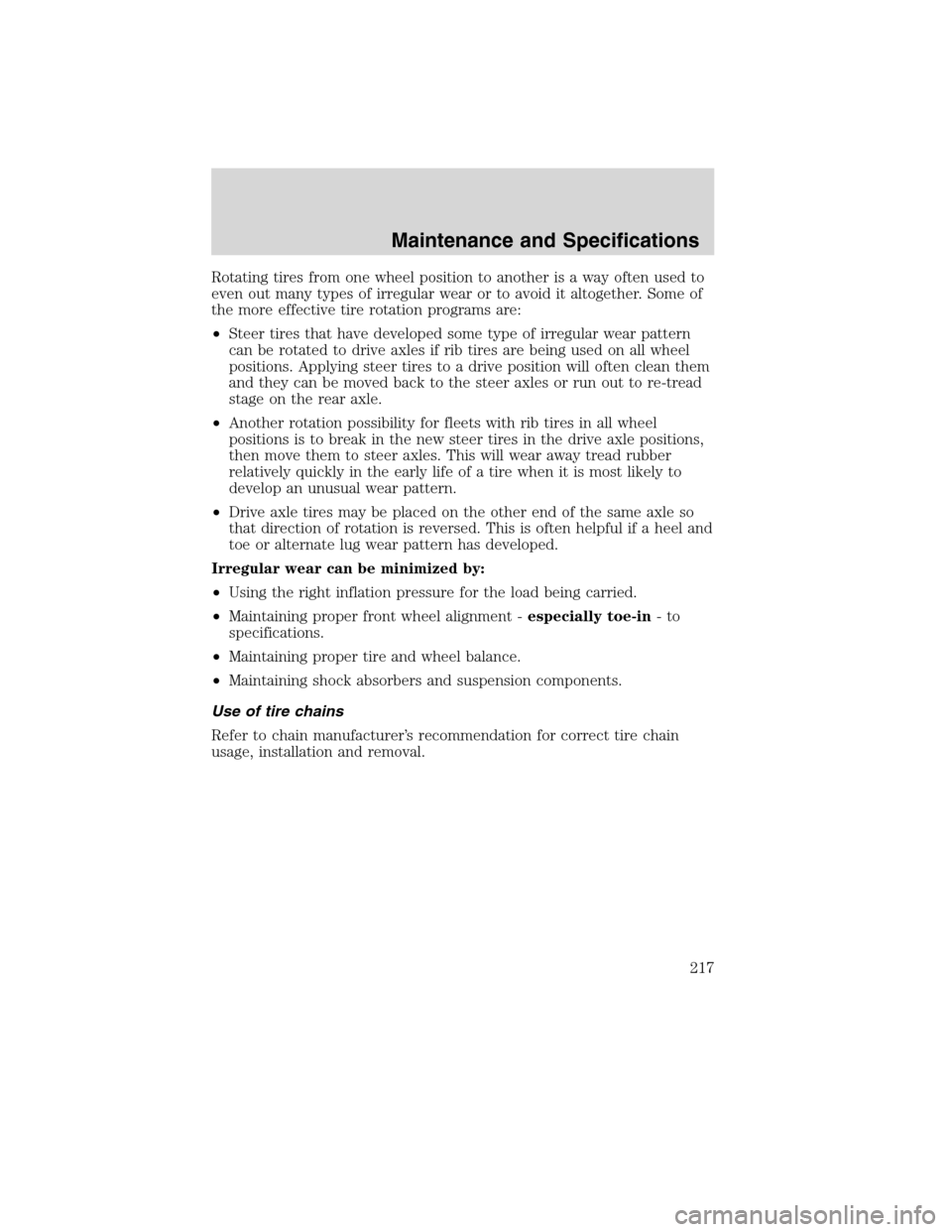
Rotating tires from one wheel position to another is a way often used to
even out many types of irregular wear or to avoid it altogether. Some of
the more effective tire rotation programs are:
•Steer tires that have developed some type of irregular wear pattern
can be rotated to drive axles if rib tires are being used on all wheel
positions. Applying steer tires to a drive position will often clean them
and they can be moved back to the steer axles or run out to re-tread
stage on the rear axle.
•Another rotation possibility for fleets with rib tires in all wheel
positions is to break in the new steer tires in the drive axle positions,
then move them to steer axles. This will wear away tread rubber
relatively quickly in the early life of a tire when it is most likely to
develop an unusual wear pattern.
•Drive axle tires may be placed on the other end of the same axle so
that direction of rotation is reversed. This is often helpful if a heel and
toe or alternate lug wear pattern has developed.
Irregular wear can be minimized by:
•Using the right inflation pressure for the load being carried.
•Maintaining proper front wheel alignment -especially toe-in-to
specifications.
•Maintaining proper tire and wheel balance.
•Maintaining shock absorbers and suspension components.
Use of tire chains
Refer to chain manufacturer’s recommendation for correct tire chain
usage, installation and removal.
Maintenance and Specifications
217
2010 F-650/750(f67)
Supplement(supplement), 1st Printing
USA(fus)